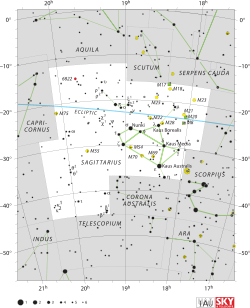Zeta Sagittarii

Location of ζ Sagittarii (circled) near the center | |
| Observation data Epoch J2000.0 Equinox J2000.0 | |
|---|---|
| Constellation | Sagittarius |
| Right ascension | 19h 02m 36.73024s[1] |
| Declination | –29° 52′ 48.2279″[1] |
| Apparent magnitude (V) | +2.59[2] (3.27/3.48)[3] |
| Characteristics | |
| Spectral type | A2.5 Va[4] |
| U−B color index | +0.05[2] |
| B−V color index | +0.08[2] |
| Astrometry | |
| Radial velocity (Rv) | +22[5] km/s |
| Proper motion (μ) | RA: +10.79[1] mas/yr Dec.: +21.11[1] mas/yr |
| Parallax (π) | 36.98 ± 0.87[1] mas |
| Distance | 88 ± 2 ly (27.0 ± 0.6 pc) |
| Absolute magnitude (MV) | 1.11/1.32[3] |
| Orbit[3] | |
| Period (P) | 21.00 ± 0.01 years |
| Semi-major axis (a) | 0.489 ± 0.001" |
| Eccentricity (e) | 0.211 ± 0.001 |
| Inclination (i) | 111.1 ± 0.1° |
| Longitude of the node (Ω) | 74.0 ± 0.1° |
| Periastron epoch (T) | 2005.99 ± 0.03 |
| Argument of periastron (ω) (secondary) | 7.2 ± 0.6° |
| Details | |
| Surface gravity (log g) | 3.90[6] cgs |
| Temperature | 8,799[6] K |
| Rotational velocity (v sin i) | 77[7] km/s |
| Other designations | |
Zeta Sagittarii (Zeta Sgr, ζ Sagittarii, ζ Sgr) is the third brightest star system in the constellation Sagittarius, with an apparent visual magnitude of +2.59.[2] It has the traditional name Ascella. Based upon parallax measurements, the distance to Ascella is about 88 ly (27 pc).[1] Ascella is moving away from the Solar System with a radial velocity of 22 km s−1.[5] Some 1.0–1.4 million years ago, this system came within 7.5 ± 1.8 ly (2.30 ± 0.55 pc) of the Sun.[8]
This is a binary star system, with the two components orbiting each other over a period of 21 years at an eccentricity of 0.211. The combined mass of the system is 5.26 ± 0.37 times the mass of the Sun[3] and their blended stellar classification is A2.5 Va.[4]
The system consists of a spectral class A2 giant with an apparent magnitude of +3.27, and an A4 subgiant with apparent magnitude of +3.48. The pair have a mean separation of 13.4 astronomical units (AU).[9] Ascella has a faint, 10th magnitude companion, separated from the primary by a distance of 75 arcseconds.
Name and etymology
- The name Ascella from a Late Latin word meaning armpit.
- This star, together with :
- γ Sgr, δ Sgr, ε Sgr, λ Sgr, σ Sgr, τ Sgr and φ Sgr consisting the asterism Teapot.[10][11]
- φ Sgr, σ Sgr, χ Sgr and τ Sgr were Al Naʽām al Ṣādirah (النعم السادرة), the Returning Ostriches.[12]
- σ Sgr and π Sgr may have been the Akkadian Gu-shi-rab‑ba, the Yoke of the Sea.[12]
- τ Sgr, ν Sgr, ψ Sgr, ω Sgr and 60 Sgr were Al Udḥiyy, the Ostrich's Nest.[12]
- In Chinese, 斗 (Dǒu), meaning Dipper, refers to an asterism consisting of ζ Sagittarii, φ Sagittarii, λ Sagittarii, μ Sagittarii, σ Sagittarii and τ Sagittarii. Consequently, ζ Sagittarii itself is known as 斗宿一 (Dǒu Sù yī, English: the First Star of Dipper.)[13]
Namesakes
- USS Ascella (AK-137) was a United States Navy Crater class cargo ship named after the star.
References
- ↑ 1.0 1.1 1.2 1.3 1.4 1.5 van Leeuwen, F. (November 2007), "Validation of the new Hipparcos reduction", Astronomy and Astrophysics 474 (2): 653–664, arXiv:0708.1752, Bibcode:2007A&A...474..653V, doi:10.1051/0004-6361:20078357
- ↑ 2.0 2.1 2.2 2.3 Johnson, H. L. et al. (1966). "UBVRIJKL photometry of the bright stars". Communications of the Lunar and Planetary Laboratory 4 (99). Bibcode:1966CoLPL...4...99J.
- ↑ 3.0 3.1 3.2 3.3 De Rosa, Robert J. et al. (2011), "The VAST Survey -- II. Orbital motion monitoring of A-type star multiples", Monthly Notices of the Royal Astronomical Society, arXiv:1112.3666, Bibcode:2012MNRAS.422.2765D, doi:10.1111/j.1365-2966.2011.20397.x
- ↑ 4.0 4.1 4.2 "CCDM J19026-2953AB -- Double or multiple star", SIMBAD Astronomical Object Database (Centre de Données astronomiques de Strasbourg), retrieved 2012-02-18
- ↑ 5.0 5.1 Wilson, R. E. (1953). General Catalogue of Stellar Radial Velocities. Carnegie Institute of Washington D.C. Bibcode:1953GCRV..C......0W.
- ↑ 6.0 6.1 Gray, R. O. et al. (October 2003), "Contributions to the Nearby Stars (NStars) Project: Spectroscopy of Stars Earlier than M0 within 40 Parsecs: The Northern Sample. I.", The Astronomical Journal 126 (4): 2048–2059, arXiv:astro-ph/0308182, Bibcode:2003AJ....126.2048G, doi:10.1086/378365
- ↑ Royer, F.; Zorec, J.; Gómez, A. E. (February 2007), "Rotational velocities of A-type stars. III. Velocity distributions", Astronomy and Astrophysics 463 (2): 671–682, arXiv:astro-ph/0610785, Bibcode:2007A&A...463..671R, doi:10.1051/0004-6361:20065224
- ↑ Dybczyński, P. A. (April 2006), "Simulating observable comets. III. Real stellar perturbers of the Oort cloud and their output", Astronomy and Astrophysics 449 (3): 1233–1242, Bibcode:2006A&A...449.1233D, doi:10.1051/0004-6361:20054284
- ↑ Kaler, James B., "ASCELLA (Zeta Sagittarii)", Stars (University of Illinois), retrieved 2012-02-18
- ↑ "Sagittarius". deepsky.astroinfo.org. Retrieved 30 August 2008.
- ↑ skywatchers
- ↑ 12.0 12.1 12.2 Allen, R. H. (1963). Star Names: Their Lore and Meaning (Reprint ed.). New York: Dover Publications Inc. p. 355. ISBN 0-486-21079-0. Retrieved 2012-09-04.
- ↑ (Chinese) AEEA (Activities of Exhibition and Education in Astronomy) 天文教育資訊網 2006 年 5 月 11 日
| ||||||||||||||||||||||||||